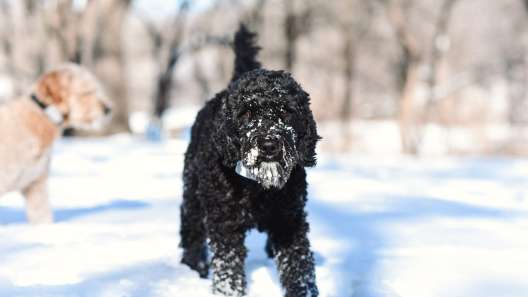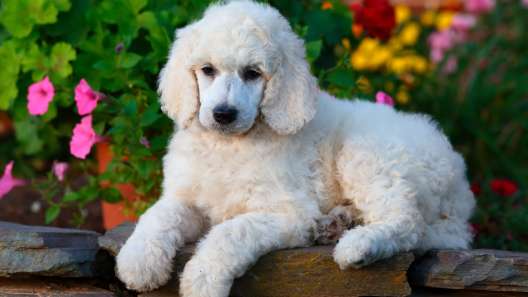
-
Activity Level:
high
-
Shedding Level:
moderate
-
Grooming Level:
moderate
-
Trainability:
high
-
Good for Novice Owners:
high
-
Adaptability:
high
-
Kid/Pet Friendly:
often
-
Prey Drive:
moderate
-
Watchdog:
aware
- Average Size: Medium
- Average Lifespan: 10-12 years
- Registered?: other
Labradoodle Dog Breed Information
Overview
Temperament
Adaptability
Health
Owner Experience
Grooming
Activity Level
Size
Life Span
Did You Know?
A Labradoodle is a cross between a Standard Poodle and a Labrador Retriever, a Labradoodle and one of the original parent breeds, or two Labradoodles. This designer dog breed originated in Australia around 1988. The main goal of the Labradoodle was to create a hypoallergenic guide dog for people living with disabilities who were also allergic to dog fur and dander.
Now, they are still a popular choice for service, guide, and therapy dogs and are also popular companion dogs. They are not currently recognized by the AKC, but they are recognized by other notable canine organizations. The American Canine Hybrid Club, Designer Dog Kennel Club, American Doodle Registry, and more recognize the Labradoodle.
Labrador Retrievers and Poodles are both friendly, gentle, intelligent, and affectionate dog breeds. The Labradoodle tends to be similar. Well-socialized Labradoodles tend to be open and friendly and crave human attention and affection. They are happiest when they are with people.
Labradoodles also tend to have an energetic and playful personality. They get along well with children, other dogs, other pets, and strangers. They are alert enough to bark or let you know when someone is at the door, but they are not generally good watchdogs or guard dogs as they are more interested in making friends. It can still be a good idea to train your dog to stop barking early to keep it from becoming a nuisance behavior.
A Labradoodle is a highly adaptable dog breed. They do very well in homes with space to run and they can adapt well to apartment living as long as they are given plenty of exercise and mental stimulation every day.
They also do well in most climates. As with any dog breed, they are sensitive to extreme heat and cold. Because they enjoy being around people, they do not generally like to be left alone for long periods of time. They can also become bored if not given enough attention, exercise, or mental stimulation, which can result in destructive behavior.
This dog breed is generally healthy, but they do have the chance of inheriting common health conditions from both of the parent breeds. Some potential health conditions to be aware of in Labradoodles can include elbow dysplasia, hip dysplasia, Addison’s disease, progressive retinal atrophy, hypothyroidism, and epilepsy.
Good breeding practices make a big difference in the health of Labradoodle puppies and can reduce the likelihood of passing on many of these health issues. Reputable breeders will screen their dogs to avoid passing preventable issues to puppies. Be sure to talk with the breeder about the genetic history of the parents and ask to see any health clearances; this can help allay potential health concerns.
A Labradoodle tends to be eager to please and highly intelligent, which makes them highly trainable. They are a good fit for dog owners of any experience level and are one of the best dog breeds for first-time owners.
As with most dog breeds, Labradoodles respond best to training that is consistent and uses positive reinforcement. Ongoing training and learning new tricks throughout your dog’s life help keep them interested, engaged, and provide plenty of mental stimulation. You can also look for puppy training classes that host supervised and safe puppy play sessions for extra socialization and bonding.
There are some grooming tasks that are common to every dog breed. When it comes to coat care, it can vary with a Labradoodle depending on the type of dog coat they inherit. Poodles have a low-shedding coat that is also high maintenance in terms of brushing, trimming, and professional grooming. Labs tend to have a higher shedding coat that needs minimal brushing and grooming.
For the most part, a Labradoodle will have a low or non-shedding coat that will need to be brushed every day. But, they can have a higher shedding coat should they take after their Labrador parent, which would need brushing a few times a week. Depending on coat type, bathing needs will be monthly/bi-monthly or just as needed. You may also need a few professional grooming sessions throughout the year.
In addition to coat care, you will also need to take care of your Labradoodle’s nails, ears, and teeth. Nail trimming once or twice a month is usually enough to keep movement comfortable and prevent longer nails from snagging on things. Proper dental care for your dog will help prevent gum disease and tooth decay. It can include brushing your dog’s teeth or using an enzyme toothpaste every day along with regular vet visits, a dental care diet, and dental chews.
It’s important to regularly check any dog’s ears, but is especially important for floppy ears. Drop-down ears are more prone to infection because floppy ears are more likely to trap moisture, dirt, and debris. By checking your dog’s ears and carefully cleaning them as needed, you can reduce the chance of your Labradoodle developing an ear infection.
It’s a good idea to start getting your dog used to having their mouth, ears, and paws handled as a puppy and rewarding them for grooming sessions. This will make grooming throughout their life a much more enjoyable process for both you and your dog. It can even help you build a bond with your dog and become something they look forward to as well.
Labradoodles tend to be high-energy dogs. They require a few daily walks plus some time to run and play in order to stay happy and healthy. They certainly love to play and you may tire out before they do sometimes. They may calm down a little as they get to be a couple of years old, but they tend to be quite energetic as puppies and experience extended puppyhoods.
Going swimming with your dog, taking a hike with them, going on a trip to the dog park, playing a game of fetch, and more are all great supplemental activities to ensure your Labradoodle gets plenty of exercise. You can even train them to compete in dog sports like dock diving, flyball, agility, obedience, and more once they have been cleared for higher-impact activities. Until puppies finish growing, it’s important to keep things low-impact to avoid damaging developing bones and joints.
Fully-grown Labradoodles will usually stand 21-24 inches tall at the shoulder and weigh 50-65 pounds.
Labradoodles generally live for 10-12 years on average.
The term “Labradoodle” first appeared in 1955. However, it did not become popular until 1988 when the mix was specifically bred to create hypoallergenic guide dogs.









